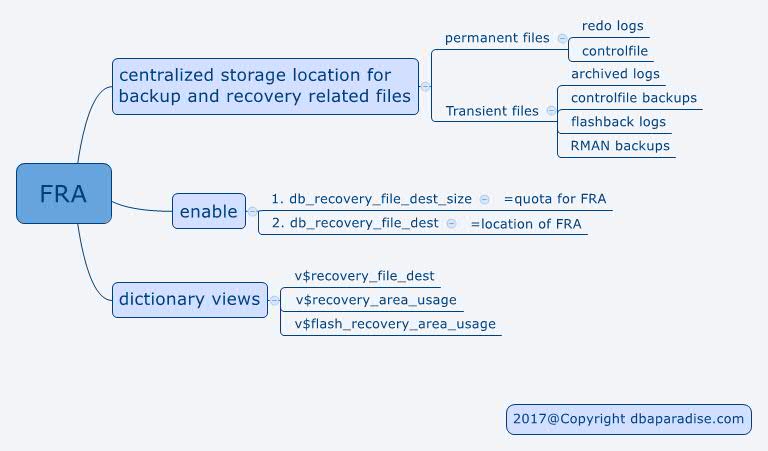
3 Questions Answered About FRA – What, Who, How?
Is it Flash Recovery Area or Fast Recovery Area?
Well, you are not wrong calling it either or, but better call it FRA (then everyone knows what you are talking about).
Back in the 10g and 11gR1 days, FRA stood for Flash Recovery Area.
Starting with 11gR2 all the way up to present, FRA stands for Fast Recovery Area (which in my opinion makes more sense).
When I say Flash Recovery Area, my mind goes to flashback logs, and without a second thought I associate FRA with the flashback functionality.
But FRA is so much more then just flashback logs.
If you forgot what FRA is, what is stored there and how to enable it, don’t panic. I bet lots of DBAs are in the same boat as you! All of us need a bit of a refresher from time to time.
What matters is that you are here, reading this post! And today’s post will answer your questions about the FRA.
1. What Is Fast Recovery Area?
2. Who (What) Is Stored In The Fast Recovery Area?
3. How To Enable The Fast Recovery Area?
4. Bonus: Where To Check For More Information?
1. What Is Fast Recovery Area?
Fast Recovery Area aka Flash Recovery Area aka FRA is a centralized storage location for backup and recovery related files.
The FRA concept was introduced in 10g. That being said many Oracle shops have not embraced the FRA, even in 12c.
Are you using the FRA? Let me know in the comments section, I read every comment!
2. Who (What) Is Stored In The Fast Recovery Area?
FRA stores 2 types of files: permanent files and transient files.
A permanent file is a file that will never be deleted by Oracle, and whos life will never become obsolete. Multiplexed control files and redo logs belong to this category.
A transient file is a file that eventually will be deleted by Oracle. Archived logs, flashback logs, RMAN backups belong to this category.
If you plan on storing all these files in the FRA, then you need to ensure there is enough space for the following:
- a copy of all the datafiles
- incremental backups (depending on your backup strategy)
- archived logs
- online redo logs
- control files
- backups of the controlfiles
- flashback logs if applicable.
Depending on your database size, the FRA size can get pretty big.
This brings me to ask the question: What happens when the FRA is full? What happens when a backup fails because there is not enough free space in the FRA?
You might be tempted to say “Not a big deal!”, but just think about it for a minute…
If the archiver process cannot write archived logs to disk, what happens to the database? The database hangs, people cannot login, an outage just got created!
Please note, I am not saying not to implement the FRA! I am just bringing awareness of possible challenges the FRA could create.
To implement the FRA properly and not come across these type of problems, more thought needs to be put into the process, and some extra setup is required.
3. How To Enable The Fast Recovery Area?
There are 2 init.ora parameters that need to be set, in order to setup the FRA. What is interesting about this, and it makes sense, is the fact that you need to set the parameters in a specific order.
To enable the FRA, set these parameters:
1. First you must set the size of FRA: db_recovery_file_dest_size
2. Second set the location of FRA: db_recovery_file_dest
Both parameters can be set with an alter system command:
SQL> ALTER SYSTEM SET DB_RECOVERY_FILE_DEST_SIZE = 100G SCOPE=BOTH SID='*'; SQL> ALTER SYSTEM SET DB_RECOVERY_FILE_DEST = '/u01/oradata/backups' SCOPE=BOTH SID='*';
4. Bonus: Where To Check For More Information?
There are 2 views that will be useful for you to query:
v$recovery_file_dest – disk quota and current disk usage in the FRA.
v$flash_recovery_area_usage – usage information about FRA.
v$recovery_area_usage – usage information about FRA.
Information in this document is valid for Oracle database versions 10g to 12c.
If you enjoyed this article, and would like to learn more about databases, please sign up below, and you will receive
The Ultimate 3 Step Guide To Find The Root Cause Of The Slow Running SQL!
–Diana
We use FRA. It is really a cool feature 🙂
[…] You understand what the Fast Recovery Area aka FRA is, what files are stored there and how to enable it. If you need a refresher, check out last week’s post here: 3 Questions Answered About FRA – What, Who, How?. […]
As a DBA, I’ve been going across many blogs over the past 5 years, and I found this ‘THE BEST”
The way you explains can be understood by a layman as well.
I request you to post few on recovery concepts, explaining the real difference between complete and incomplete recovery and when to go with what with few scenarios provided.
Thanks,
Sri.
Hi Sri! Thank you for your kind words! I’ll take note of your request! Stay tuned for future posts!
Thank you very much sir for this simple, sweet and crisp content of FRA.